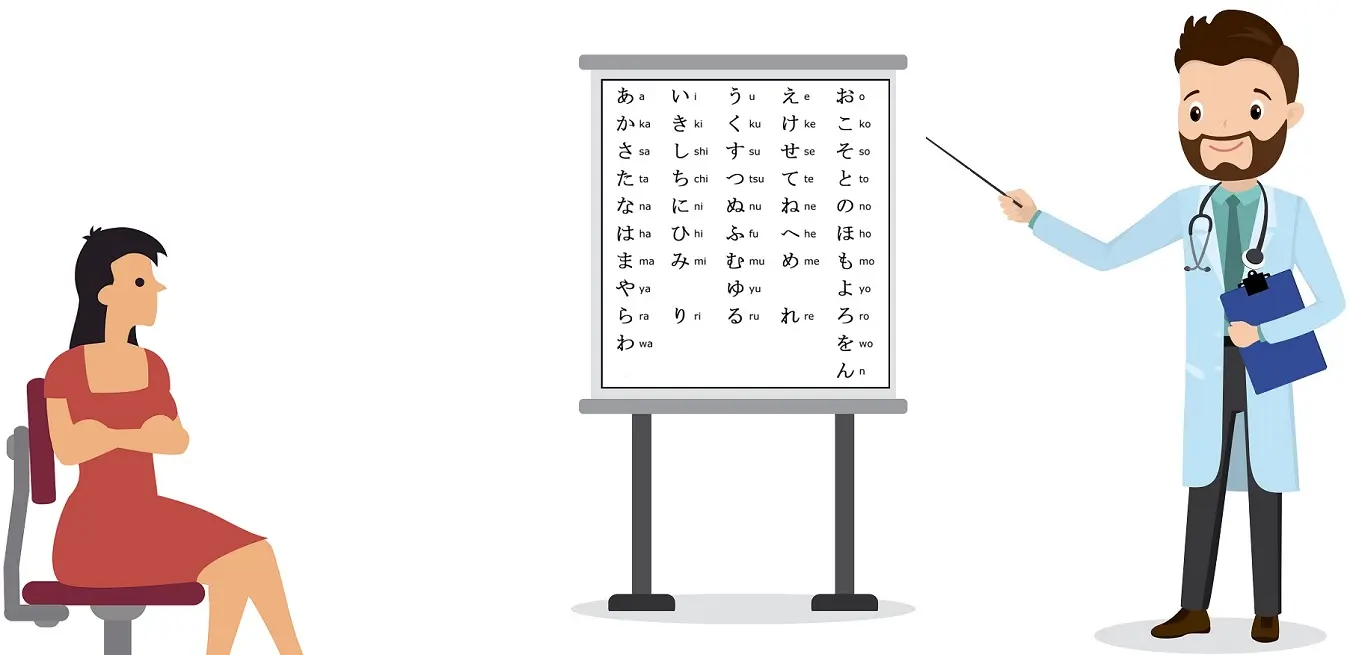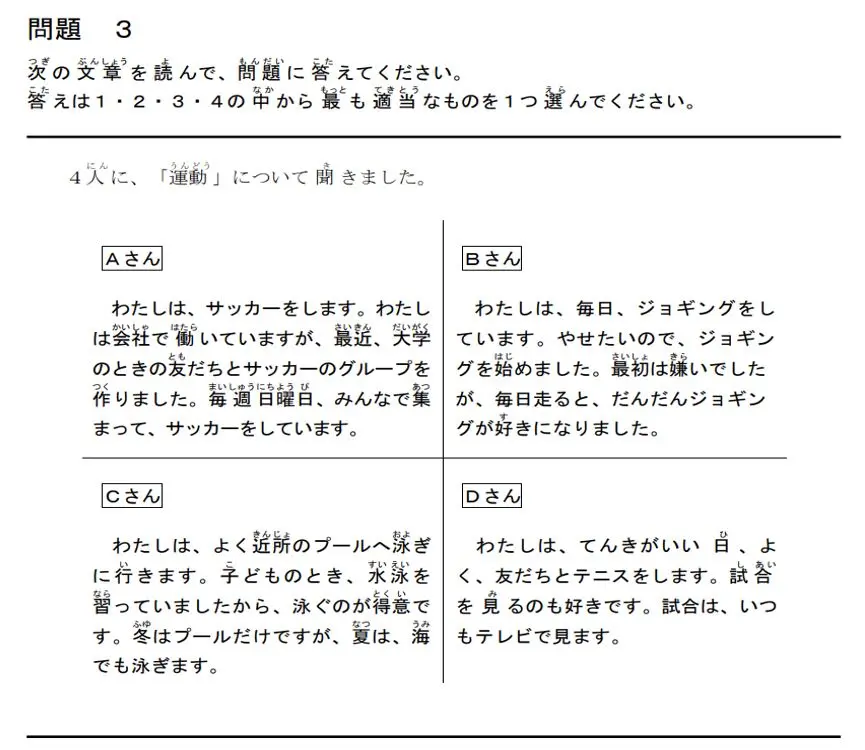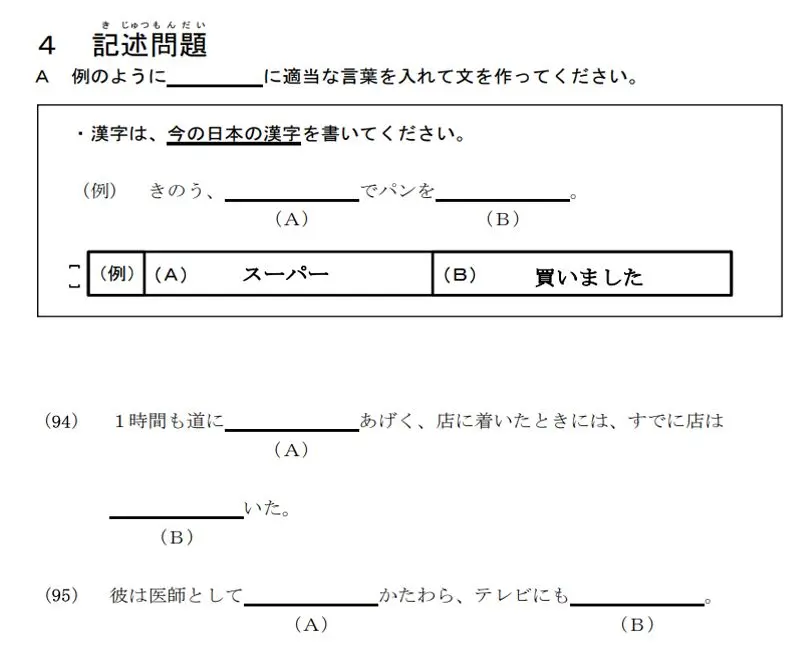J.Test for Practical Japanese

The full name of the J.TEST is Jitsuyo Nihongo Kentei (実用日本語検定), which means Practical Japanese Test. J.Test was first created in 1991 by the Japanese Language Proficiency Association company Go-bun Kenkyū-sha K.K.
What is J.Test?
As the name suggests, J.Test’s objective is to test the practical Japanese communication level of the examinees. When we say practical, we mean the focus is to test the ability to use Japanese practically. To achieve this, the J.test focuses more on listening and writing skills, along with Japanese vocabulary and reading skills.
Considering that J.Test gives more weight to practical communication abilities, this test is standard for many major Japanese corporations, schools, and universities to measure candidates’ Japanese skills. Even some institutions consider J.Test certification as the yardstick for scholarship eligibility criteria.
Currently, the average number of people who take the test is approximately 60,000 worldwide, which is much less than the JLPT test. The reason is that, unlike the JLPT, the J.Test is only available in Asian countries apart from Brazil.
J.Test Levels
Currently, the J.Test offers the following three levels:
- F/G Level test for beginner-level Japanese
- D/E level test for intermediate-level Japanese
- A/C level test for advanced-level Japanese
Levels A/C and D/E have writing tests, while all the test questions in levels F/G only offer multiple choice questions.
The names of the J.Test levels are based on the grades awarded according to the marks received by the examinee. For example, A/C levels will have grades A, B, or C depending on the points earned, and the D/E level will have passing grades as D or E.
F/G Level of J.Test
The lowest level F/G is meant for beginners who don’t have much experience in Japanese. It is the equivalent of the N5 level of the JLPT. There are two sections, which are divided further into four sections each as per the following table:
| Reading Comprehension (60 minutes) | Listening comprehension (25 minutes) |
|---|---|
| Grammar and vocabulary questions | Picture (photo) problems: -See the picture, listen to the questions, and select the correct answer |
| Reading comprehension | Listening-reading comprehension |
| Kanji Problems | Listening and responding to questions |
| Short sentence creation problem: -Multiple choice problems to rearrange sentences | Conversation and Explanation questions Multiple choice |
Passing the exam will be based on the points earned out of 350, with a minimum score of 180. Examinees cannot earn a zero in any section to pass the exam.
Question Contents in F/G Level
Questions for the test will include solving grammar and vocabulary problems, reading comprehension, kanji problems, and short sentence creation problems.
Examinees must read a sentence and choose the correct answer that best fits the sentence’s meaning. You’ll have to choose the correct kanji or hiragana reading that fits the sentence for kanji problems. All questions for the reading comprehension section will be multiple-choice.
Example Questions in F/G Level
Choose the most appropriate word that fits the sentence.
「お 国 くに は、( )ですか」
- どなた
- なんで
- いくつ
- どちら
Choose the best phrase that fits the underline part.
けさ、地 ち 下 か 鉄 て つ に 乗 の りました。
- きのうの 朝 あ さ
- きのうの 夜 よ る
- きょうの朝
- きょうの夜
After the reading comprehension test, the listening portion will begin immediately without a break. Questions for the listening portion will also be multiple-choice as well.
In part one, you’ll view a picture, listen to a conversation, and choose the best-fit response. For the next three portions of the test, you’ll listen to a conversation and be asked to choose the best response.
Scores & Evaluation of F/G Level
G Grade: Requires 180 points or more. This signifies the examinee can communicate at a beginner level of Japanese, use basic greets, and recognize simple words and kanji.
F grade: Requires a minimum of 250 points.
Communication skills are within the first half of the Japanese elementary level. Examinees can recognize basic words and greetings and form simple sentences.
You will not receive certification for those who score less than 180 points.
D/E Level of J.Test
The second lowest level is D/E and is meant for those with a higher beginner to low intermediate level of Japanese. It’s equivalent to the N4 and N3 of the JLPT. Receiving certification at this level requires a minimum score of 350 points out of 700.
| Reading Comprehension (60 minutes) | Listening comprehension (25 minutes) |
|---|---|
| Grammar and vocabulary questions | Picture (photo) problems: See the picture, listen to the questions, and select the correct answer |
| Reading comprehension: -Short passages and conversations -short written response | Listening-reading comprehension |
| Kanji Problems: Kanji and vocabulary replacement | Listen and respond to questions: Multiple choice and written |
| Short sentence creation problem: Multiple choice problems to rearrange sentences | Conversation and Explanation questions: Multiple choice |
Question contents of D/E Level
Questions for the test will include solving grammar and vocabulary problems, reading comprehension, kanji problems, and short sentence creation problems.
Examinees must read a sentence and choose the correct answer that best fits the sentence’s meaning. You’ll have to choose the correct kanji or hiragana reading that fits the sentence for kanji problems.
All questions for the reading comprehension section will be multiple-choice. Passing this section will require a strong understanding of grammar, particles, and situational vocabulary. The D/E level also includes a written response portion as well, so be sure to brush up on your writing skills.
Question Examples of D/E Level
Choose the most appropriate word that fits the sentence.
午前は、ようじがありますが、午後( )だいじょうぶです。
- なら
- では
- のに
- と
Choose the best substitute for the underlined word.
手 術 が終わったと聞いて、ほっとした。
- 報 ほう 告 こく した
- 心 しん 配 ぱい した
- 安 あん 心 しん した
- 検 けん 査 さ した
After the reading comprehension test, the listening portion will begin immediately without a break. Questions for the listening portion will also be multiple-choice as well. In part one, you’ll view a picture listen to a conversation, and choose the best-fit response. For the next three portions of the test, you’ll listen to a conversation and be asked to choose the best response.


友 と も だちと 運動 うんどう するのは、だれですか。
- AさんとCさんです。
- 2 AさんとDさんです。
- 3 BさんとCさんです。
- 4 BさんとDさんです。
Score & Evaluation of D/E Level
E Grade: Requires 350 points or more. This signifies that the examinee can communicate at a beginner level of Japanese used in daily life.
D Grade: Requires a minimum of 500 points. This level signifies that the examinee can communicate at an intermediate level of Japanese.
You will not receive certification for those who score less than 350 points.
A-C Level of J.Test
The highest level of the test is the A/C level and is meant for intermediate to advanced levels of Japanese speakers. Receiving certification at this level requires a minimum score of 600 points out of 1000.
| Reading Comprehension (60 minutes) | Listening comprehension (25 minutes) |
|---|---|
| Grammar and vocabulary questions | Picture (photo) problems: See the picture, listen to the questions, and select the correct answer |
| Reading comprehension: -Short passages and conversations -short written response | Listening-reading comprehension |
| Kanji Problems: Kanji and vocabulary replacement | Listen and respond to questions: Multiple choice and written |
| Short sentence creation problem: Multiple choice problems to rearrange sentences | Conversation and Explanation questions: Multiple choice |
Questions for the test will include solving grammar and vocabulary problems, reading comprehension, kanji problems, and short sentence creation problems. Examinees must read a sentence and choose the correct answer that best fits the sentence’s meaning. For kanji problems, you’ll have to choose the correct kanji or hiragana reading that fits the sentence. The A/C level also includes a written answer response during reading comprehension and listening.
Examples of Questions of A-C Level
Choose the most appropriate word that fits the sentence.
情報が少ないので、とにかく現場に行ってみるより (?)。
- ほかはない
- しかない
- ほかならない
- あるまい
Choose the best substitute for the underlined word.
あそこのホテルはサービスが至 れり尽くせりだ。
- 必要最小限だ
- 過剰だ
- 他より劣っている
- 何もかも十分だ


After the reading comprehension test, the listening portion will begin immediately without a break. Questions for the listening portion will also be multiple-choice as well. In part one, you’ll view a picture, listen to a conversation, and choose the best-fit response. For the next three portions of the test, you’ll listen to a conversation and be asked to choose the best response to the situation.
Score & Evaluation of A-C Level
- C Grade: Requires 600 points or more. This signifies that the examinee can communicate in daily life and work. This is the equivalent of the N2 level.
- Pre-B Grade: Requires a minimum of 700 points and is the equivalent of the N1 level.
- B Grade: Requires a minimum of 800 points and is sufficient for communication in general subjects and situations.
- Pre-A Grade: Requires a minimum of 850 points. Examinees can understand most general topics in various fields and situations and have sufficient communication skills.
- A Grade: Requires a minimum of 900 points. Examinees can understand specialized topics in various fields and situations and have sufficient communication skills.
- Special A Grade: Requires 930 points or more. Examinees have advanced communication skills to understand and respond to specialized topics in various fields and situations.
You will not receive any certification if the score is 600 points or less.
J.Test Locations & Schedule
In Japan, the J.Test is offered in 13 major cities. In Tokyo, Osaka, Nagoya, and Fukuoka, the test is offered 6 times yearly. However, in Sapporo, Sendai, Shizuoka, Kobe, Kyoto, Hiroshima, Takamatsu, Oita, and Okinawa, the test is hosted 3 times a year.
Unlike the JLPT, the J.Test is offered only in 13 countries. These countries are Japan, China, Taiwan, South Korea, Mongolia, Vietnam, Thailand, Nepal, Myanmar, Laos, Indonesia, Bangladesh, and Brazil. Please note that the J.Test had been held in the Philippines also, but due to COVID, it is currently not available there.
The exam is offered multiple times throughout the year (3-6), and participants can register for the exam at least one month before the exam date. Also note that the FG level is only offered twice a year, while the AC/DE levels are offered six times a year in Japan.
Study Material and Resources for J.Test
Since the J.Test does provide a practical test of one’s Japanese abilities, it’s important to prepare for the test using real-world materials as much as possible. As of May 2019, the test also merged its business test together with the regular test so that the exam will feature a lot of common business terms and phrases used in everyday life.
The official J.Test website has downloadable materials to help you better prepare for the types of questions you’ll encounter on the test. There are monthly reading comprehension questions and practice questions with answers available for prospective test takers. There are also some practice tests available online as well. We encourage you to incorporate them into your study materials to better prepare for the test.


Jamila Brown is a 5-year veteran in Japan working in the education and business sector. Jamila is currently transitioning into the digital marketing world in Japan. In her free time, she enjoys traveling and writing about the culture in Japan.

